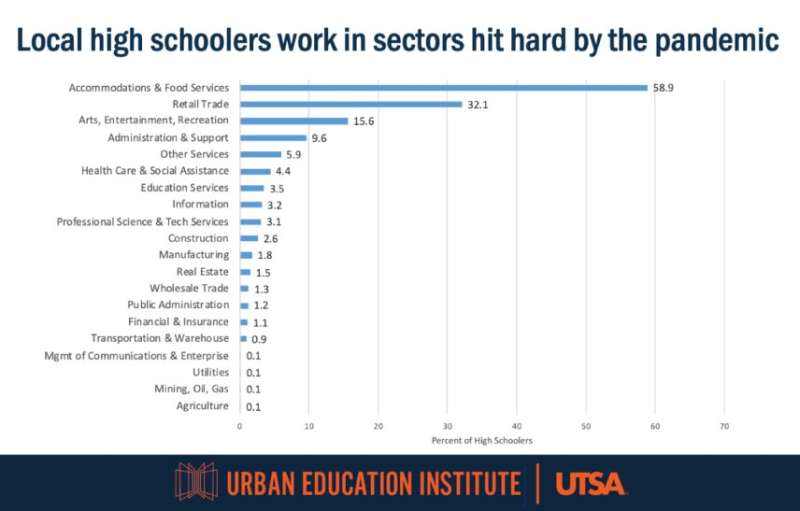UTSA and SA Works study San Antonio youth employment trends

San Antonio had an above average youth employment rate, then the pandemic struck. Among the top 50 metro areas, San Antonio youth experienced the 8th largest drop in employment in the first year of the pandemic, according to national data research organization Mathematica. What explains this decrease? The top job sectors employing high school students were the hardest hit in the pandemic's local economic downturn, based on a new study commissioned by SA Works and conducted by The University of Texas at San Antonio (UTSA) Urban Education Institute (UEI).
Prior to the COVID-19 outbreak, nearly three out of four students worked for pay at some point during their high school years, according to the study, which analyzed employment trends of approximately 211,000 Bexar County high school students. The project, the first of its kind locally, was a collaboration between the Urban Education Institute and SA Works, the workforce development team within the San Antonio Economic Development Foundation. Funded by The USAA Foundation, Inc., it analyzed employment patterns of Bexar County high school students across nearly two decades.
"It's critical to have a data-driven approach to our high school internship program and this study provided insights that we will implement to continue to provide meaningful work-based learning opportunities that support youth career readiness and builds on their social capital, said Romanita Matta-Barrera, SA Works executive director. "Furthermore, the pandemic has tightened the job market in the traditional youth employment sectors and this heightens the need for paid internships."
The top industries employing area high school students have suffered most amid the pandemic: accommodations/food services; retail sales; and arts/entertainment. Historically, 59% of high school students were employed in accommodations and food services; 32% worked in the retail trade; and 16% worked in arts/entertainment/recreation.
"We know that employment provides our youth important growth opportunities. Unfortunately, the sectors where they typically found employment were also the hardest hit by the pandemic. Now is the time redouble our efforts to expand and diversify the jobs and opportunities available to our students, either through part-time jobs, summer internships, or job-shadowing experiences," said Mike Villarreal, UEI director and assistant professor in the UTSA Department of Educational Leadership and Policy Studies. "We need to get creative. Research has found that workplace learning benefits adolescents in small and big ways. The workplace is often where youth are inspired to pursue a future career and where they learn the norms that adults take for granted."
Villarreal adds that existing local initiatives such as SA Works, that link students and local employers, should be expanded to build college and career awareness and readiness. He called on employers to build more formalized opportunities with schools and to offer paid internships and apprenticeships, as well as job shadowing and other forms of learning about the workplace.
SA Works provides support to local employers and students to ensure that internship programs are successful and that employers are able to effectively mentor, supervise and engage interns. At 9 a.m. on Wed., May 19, the organization will host a virtual Employer Training Session to share insights for structuring a successful internship program.
For the youth employment trends study, the UEI used student-level, longitudinal data collected by the Texas Education Agency and the Texas Workforce Commission and stored at the University of Texas Education Research Center. Researchers also analyzed the Bexar County high school internship landscape as part of the collaboration. Additionally, the team conducted survey interviews with 28 SA Works Summer Internship Program alumni. Local employers also provided insights about the SA Works internship through a series of in-depth interviews.
In summary, the youth employment trend study's top findings included:
- Nearly 3 out of 4 high school students worked for pay at some point during their high school years.
- The top industries employing Bexar County high school students were those hit hardest by the pandemic economic downturn: food services, retail and arts and entertainment.
- Employment rates for Hispanic, White and Black students were statistically equivalent, but a smaller proportion of Asian students worked during high school.
- Students with limited English proficiency and students who received special education services were employed at much lower rates, suggesting these two populations need for more support in securing workforce opportunities.
- High school students spend more time working as they age and spend more time working during the summers at all ages.
- No statistical difference in completing advanced high school and college preparatory coursework was found between students who worked and those who did not.
More information: uei.utsa.edu/_files/pdfs/HSEmployment_Final1.pdf





















